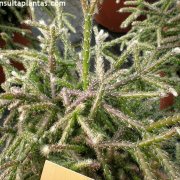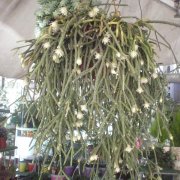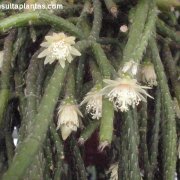Care of the indoor plant Rhipsalis pilocarpa or Hairy Stemmed Rhipsalis |
|
The genus Rhipsalis, family Cactaceae, comprises 35 species of cacti native to tropical regions of Central and South America, Africa and Asia. Some species are: Rhipsalis pilocarpa, Rhipsalis baccifera, Rhipsalis burchellii, Rhipsalis cruciformis, Rhipsalis oblonga, Rhipsalis puniceodiscus, Rhipsalis baccifera, Rhipsalis pachyptera, Rhipsalis cassutha, Rhipsalis rosea. Common names: Hairy Stemmed Rhipsalis, Hairy-fruited wickerware cactus. Scientific synonyms: Rhipsalis peluda, Erythrorhipsalis pilocarpa. This species is native to Brazil. They are epiphytic cacti with a pendant bearing and cylindrical stems that reach 40 cm (15.74") in length. The woolly areolas are oval and have 3-10 whitish spines. The flowers are white, 4 cm (1.57") in diameter and appear at the end of the stems. The fruits are red and very decorative. Hairy Stemmed Rhipsalis is used in hanging pots as indoor plants, greenhouses and on terraces and patios. Rhipsalis pilocarpa can be grown in full sun or semi-shade exposures. The winter safety temperature is 6 ºC (42.8 ºF). The soil can be a mixture of 25% coarse siliceous sand and 75% leaf mulch or heather soil. Water with lime-free water frequently in spring and summer so that the substrate does not dry out completely (never flood). In summer periodically spray the stems with lime-free water. Fertilize once in spring with mineral fertilizer for cacti. Hairy Stemmed Rhipsalis does not need pruning. Rhipsalis pilocarpa can be attacked by mites and aphids if ventilation is not proper and it suffers from drought. Hairy-fruited wickerware cactus propagates easily by seed or stem cuttings in spring. |
Images of the indoor plant Rhipsalis pilocarpa or Hairy Stemmed Rhipsalis |
Find plants
Rhipsalis pilocarpa or Hairy Stemmed Rhipsalis | Care and Growing
© 2025 FavThemes


